Focus on Operational Efficiency
Operational efficiency remains a critical driver within the Museum Software Market. Museums are increasingly adopting software solutions that streamline administrative tasks, manage collections, and optimize resource allocation. By automating routine processes, institutions can allocate more time and resources to curatorial and educational initiatives. Recent statistics indicate that museums utilizing comprehensive management software report a 30% increase in operational efficiency. This trend underscores the importance of software that integrates various functions, such as ticketing, membership management, and inventory control. As museums seek to maximize their impact with limited budgets, the demand for efficient software solutions is likely to continue rising.
Rise of Remote Access Solutions
The rise of remote access solutions is transforming the Museum Software Market. As institutions adapt to changing visitor behaviors, the ability to offer virtual access to collections and exhibitions has become essential. Software that enables remote viewing and participation in educational programs allows museums to reach a broader audience, transcending geographical limitations. Recent data indicates that museums offering virtual tours see a 40% increase in overall engagement. This trend not only broadens the reach of museums but also provides an additional revenue stream through online ticket sales and memberships. Consequently, the demand for robust remote access software is likely to grow, shaping the future of the Museum Software Market.
Growing Emphasis on Data Analytics
The Museum Software Market is witnessing a growing emphasis on data analytics as institutions seek to leverage visitor data for strategic decision-making. By analyzing visitor behavior, preferences, and demographics, museums can tailor their offerings to better meet audience needs. This data-driven approach not only enhances visitor engagement but also informs marketing strategies and exhibition planning. Recent findings suggest that museums employing data analytics tools experience a 25% increase in targeted outreach effectiveness. As the importance of data in shaping museum experiences becomes more pronounced, the demand for sophisticated analytics software is expected to rise, further propelling the Museum Software Market.
Increased Demand for Digital Engagement
The Museum Software Market experiences a notable surge in demand for digital engagement tools. As museums strive to enhance visitor experiences, the integration of interactive exhibits and mobile applications becomes paramount. This shift is driven by a growing expectation for immersive experiences among visitors, particularly younger demographics. According to recent data, approximately 70% of visitors express a preference for museums that offer digital interactions. Consequently, software solutions that facilitate virtual tours, augmented reality experiences, and gamification are increasingly sought after. This trend not only enhances visitor satisfaction but also encourages repeat visits, thereby contributing to the overall growth of the Museum Software Market.
Increased Funding for Cultural Institutions
Increased funding for cultural institutions is a significant driver in the Museum Software Market. Governments and private entities are recognizing the value of museums in preserving cultural heritage and promoting education. This influx of funding often translates into investments in technology, including advanced software solutions. Recent reports indicate that funding for cultural institutions has risen by 15% over the past year, enabling museums to upgrade their software systems and enhance operational capabilities. As financial support continues to grow, the Museum Software Market is poised for expansion, with institutions seeking innovative solutions to improve visitor experiences and operational efficiency.


















Leave a Comment